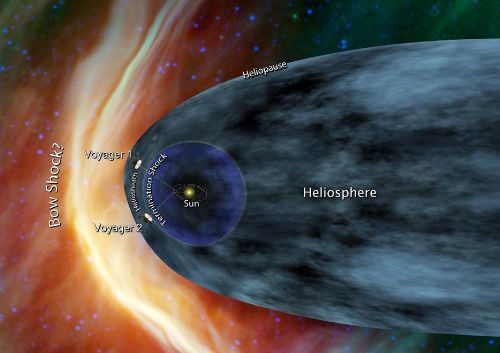by Larry
September, 2013Far Out!In 1977, when a rocket launch pushed Voyager 1 free enough of Earth's gravitational pull to commence its long journey, National Atmospheric and Space Administration engineers did not know how long it would be sending radio waves. Yet 36 years later it is continuing to broadcast and is now believed capable of perhaps still sending signals strong enough to be picked up by a few of our telescopes for another dozen years.
Yet it almost certainly will keep moving farther from us and our sun. In "only" 40,000 years, it could be within 2 light years of another star. As many may recall, this pioneer space traveler carries a record, capable of being played by a distant intelligence, to communicate many of the sounds of our world and species. The odds against that ever occurring are great, however it is just slightly possible that one day another kind of being will find in Voyager 1 proof that it is not completely unique or alone in the vastness of space. The craft has already provided NASA scientists with surprising data. They had anticipated that as Voyager 1 left the Solar System it would detect a new alignment of the prevailing magnetic field. Instead, they found that our sun's magnetic field and that of the Milky Way Galaxy of which we are a small part are lined up the same way. Other scientists, more skeptical, believe this indicates that, despite evidence interpreted a few days ago as showing Voyager 1 was outside our sun's solar wind, it may yet take another year or two before the craft is truly free of the sun's system. Others note that the definition of where the Solar System ends is inexact. For instance, though Voyager 1 is now known to be beyond both the planets and the solar wind, it will take thousands of years of further travel before it is beyond the cluster of comets and the cloud of large hunks of ice that, like Pluto, are still in orbit about the sun from distant reaches. Nonetheless, even if not yet beyond our solar system by all meanings of that term, it is certainly a far expanse away. Scientists agree that the craft's progress has taken it beyond the heliosphere and that this was actually accomplished in August of last year. Just 55 years after Soviet Russia's space program successfully put Sputnik in orbit above Earth's atmosphere, NASA has successfully sent a craft beyond the sun's atmosphere as well. Not bad. Primary sources: A Blue Dot in a Cosmic Ocean: Radio Signal from NASA's Voyager 1 As It Travels Outside Our Solar System Is Seen from Earth for the First Time. Associated Press in Mail Online; September 17, 2013. Where in the Solar System Has Voyager 1 Wound Up? Glenn Fleishman in Boing Boing; September 12, 2013. Voyager 1 Leaves Solar System, NASA Confirms. Dan Vergano in National Geographic; September 12, 2013. |
